During my recent Dhaka-Sylhet trip, I paid attention to the busses (well, if you are going on any highway in Bangladesh, you have no choice, because, by their aggressive driving, busses make sure you pay attention to them.) But cussing them gets boring after a while, so I started reading their names. Soon I had a list.
For some, family was important:
BAI BAI (brother-brother - or, wait, maybe it is meant to be BYE-BYE)
Mayer Doa (Mother's blessing)
Ma Babar Doa (Mother's and Father's blessings)
Mayer Doya (Mother's kindness)
Mayer Achol (Mother's sari's corner)
Stand out from the crowd:
Ovi Motors Welcome You Are Welcome
Dhaka-Habiganj Special
Rimjhim Special
Shyamoli Special
HI Deluxe
SU> Deluxe
Avizat Motors (Aristocrat Motors)
Hanif Exclusive Business Class
Exclousive
Rahbar Symbol of Aristocracy
Some names had religious connotations:
Allah Varosha (Depend on Allah)
Allahr Daan (Gift of Allah)
Holy City (reference to Sylhet)
Some used proper nouns:
Masud Shohel
Lovley Eva
Runa
Sakib
Names to denote speed:
Birotihin (non-stop)
Agradut (the one in front)
ARABIAN (like the horse?)
Entering Dhaka I saw the bils:
Ababil (a bird)
Anabil (free)
Salsabil (?)
What was this doing inside Bangladesh?
TRTC, Govt of Tripura
My Absolute Favorite:
Emon Lemon (A Lemon Like This)
If I had my way I would call them:
Get out of my way or else
Brakes? What are those?
Take no prisoner
Roadkills R Us
Disowned by Mother
Don't be a Sissy - being crushed by a bus never hurt anyone
I am BIG you are small NYA NYA
It would be fascinating to ask the bus owners the reason for the name they had bestowed on their bus. But if I ever meet an owner, it would be even more fascinating to grab their collar, shove them against a wall, and ask them why they had hired the most dangerous drivers on the planet to kill people - erm, I mean, to drive their busses.
Showing posts with label Sylhet. Show all posts
Showing posts with label Sylhet. Show all posts
Sunday, August 05, 2007
Saturday, August 04, 2007
Sun Comes Out
The sun finally came out, though I am not sure if it is too late to prevent a Megaflood that everyone keeps talking about. The big floods are determined by the level of the major rivers when they crest for the season. With floods ongoing in Assam and Nepal, I can't help being pessimistic.
Then of course a lot of people are already suffering. Last Wednesday I was at my friend Bappu's office when his phone rang. It was his friend from Sirajganj, on the western side of the Jamuna. The friend was calling from the second floor of his house - the ground floor was already submerged. Ouch.
Nevertheless the sun did come out yesterday and today. Here are some pictures from a short trip I made to Sylhet the last two days.
Train crossing through paddy field near Habiganj. When we Sylhet division and entered Brahman Baria, the paddies were replaced by miles of water.

Clothes being dried in the sun. As soon as the sun came out, people frantically started drying things. On the highway, they sometimes took over small rectangular patches to dry fresh-cut paddy - leaving just enough room for a bus or car to pass. They also dried lots of wood, skewered patties of cow-dung, and a reed-like plant used to make string and rope.

Sun peeking through the trees at a tomb in Pir Moholla, Sylhet. Hajrat Shah Jalal, the famous holy man of Sylhet, had his first base around here.

View of the Khasi-Jaintiya Hills (in Meghalaya) from Tamabil road.

Then of course a lot of people are already suffering. Last Wednesday I was at my friend Bappu's office when his phone rang. It was his friend from Sirajganj, on the western side of the Jamuna. The friend was calling from the second floor of his house - the ground floor was already submerged. Ouch.
Nevertheless the sun did come out yesterday and today. Here are some pictures from a short trip I made to Sylhet the last two days.
Train crossing through paddy field near Habiganj. When we Sylhet division and entered Brahman Baria, the paddies were replaced by miles of water.

Clothes being dried in the sun. As soon as the sun came out, people frantically started drying things. On the highway, they sometimes took over small rectangular patches to dry fresh-cut paddy - leaving just enough room for a bus or car to pass. They also dried lots of wood, skewered patties of cow-dung, and a reed-like plant used to make string and rope.

Sun peeking through the trees at a tomb in Pir Moholla, Sylhet. Hajrat Shah Jalal, the famous holy man of Sylhet, had his first base around here.

View of the Khasi-Jaintiya Hills (in Meghalaya) from Tamabil road.

Wednesday, May 30, 2007
My Stomping Grounds in Sylhet
My hometown is Sylhet. I lived there until about ten, but after we moved to Dhaka, I gradually became estranged from Sylhet. This was partly because Shawkat House, my grandfather's sprawling estate of several bungalows where I spent my first eight years, was sold in 1973. With it went a lot of my childhood memories. Another reason was that I hardly had any friends left in Sylhet. Also, in the 80s and 90s, due to poor infrastructure development and population pressure, Sylhet became congested and unpleasant. This has improved significantly in recent years.
Since returning to Bangladesh I have made several trips to Sylhet to rekindle the relationship, as it were. Here are some pictures of the stomping grounds of my childhood.
The only remaining original Shawkat House bungalow. This was the "outer" building and my Father's office.

This gate led to the inner bungalows and courtyards. Unfortunately the entire inner structure has changed so much that I could not recognize it.

Across the street from Shawkat House is the pond where I learned to swim. I also did a fair amount of pearl-diving here at the ripe age of eight and gave the largest pearl to my Mother. She had a ring made around it and, years later, gave it to my wife.

Next door to our house was this "moholla" called Shekh Para. In the front there were several date palms and a large pond. I was happy to find a palm standing.

But the pond was filled in with sand.

Out of Shekh Para came several illustrious people, including the Qureshi family, now in London, which has three elected London City Councillors from the same family. Must be a record of some kind!
A few doors down from Shawkat House was Shadhu Babu's house. He is a friend of the family, and his daughter married R. P. Saha's son. (R. P. Saha was a prolific industrialist and a prominent philanthropist of Bangladesh. Both Mr. Saha and his son were killed by the Pakistan Army in 1971. Shadhu Babu is alive.)

The compound of Shadhu Babu's house had a massive "Bokul" tree. My grandmother and I used to stop there during our morning walk and pick the tiny, fragrant flowers. The tree is gone, leaving this patch of land.

My first school was Blue Bird School. The school moved several times when I was attending it and occupied this building - now a dilapidated government office - when I was in 4th and 5th grade.

Our Assembly took place in the hall just inside this entrance.

Nowadays Blue Bird (located in a nice new location) is a BIG school, going all the way to 12th grade :-)

Also within walking distance was "Nanubasha" - my maternal Grandparents' home. There were many children my age there. Hence I went there every chance I got. This is the entrance with the large "dalan" structure dating back to 1911. My Nanu, and several families of my Nana's relatives, lived in separate bungalows in the inner house, taking the path curving around the side of the Dalan. (My Nana passed away before I was born.)

Another view of the "Dalan", made in 1911 with stone, bricks and sand before cement became available.

Nanubasha is formally known as "Ahia Villa". Mr. Ahia, also known at Jeetu Mia, was one of the most colorful and eminent residents of Sylhet in the early 1900s, and the first one with a motor car. This is the tomb of Mr. Ahia and Sara, his first wife.

Two or three years ago, an incredibly ill-conceived government plan was drawn up to build another bridge on the Surma that would effectively destroy Ahia Villa (due to road widening required for this bridge.) It boggled the imagination that such a historical house - Gandhi had spent time in this house, Dr. Syed Mujtaba Ali had studied there - could be cast aside so casually. Luckily a storm of protests followed, and the plan, while still alive, has been slowed. It needs to be stopped.
Incidentally, if you write a letter to someone in Ahia Villa, it is enough to address it as "Ahia Villa, Sylhet" and the post office will deliver it. The only house in Sylhet for which you don't need a numbered street address!
(I am grateful to Dr. Shama Ali for pointing out the R. P. Saha connection.)
Since returning to Bangladesh I have made several trips to Sylhet to rekindle the relationship, as it were. Here are some pictures of the stomping grounds of my childhood.
The only remaining original Shawkat House bungalow. This was the "outer" building and my Father's office.

This gate led to the inner bungalows and courtyards. Unfortunately the entire inner structure has changed so much that I could not recognize it.

Across the street from Shawkat House is the pond where I learned to swim. I also did a fair amount of pearl-diving here at the ripe age of eight and gave the largest pearl to my Mother. She had a ring made around it and, years later, gave it to my wife.

Next door to our house was this "moholla" called Shekh Para. In the front there were several date palms and a large pond. I was happy to find a palm standing.

But the pond was filled in with sand.

Out of Shekh Para came several illustrious people, including the Qureshi family, now in London, which has three elected London City Councillors from the same family. Must be a record of some kind!
A few doors down from Shawkat House was Shadhu Babu's house. He is a friend of the family, and his daughter married R. P. Saha's son. (R. P. Saha was a prolific industrialist and a prominent philanthropist of Bangladesh. Both Mr. Saha and his son were killed by the Pakistan Army in 1971. Shadhu Babu is alive.)

The compound of Shadhu Babu's house had a massive "Bokul" tree. My grandmother and I used to stop there during our morning walk and pick the tiny, fragrant flowers. The tree is gone, leaving this patch of land.

My first school was Blue Bird School. The school moved several times when I was attending it and occupied this building - now a dilapidated government office - when I was in 4th and 5th grade.

Our Assembly took place in the hall just inside this entrance.

Nowadays Blue Bird (located in a nice new location) is a BIG school, going all the way to 12th grade :-)

Also within walking distance was "Nanubasha" - my maternal Grandparents' home. There were many children my age there. Hence I went there every chance I got. This is the entrance with the large "dalan" structure dating back to 1911. My Nanu, and several families of my Nana's relatives, lived in separate bungalows in the inner house, taking the path curving around the side of the Dalan. (My Nana passed away before I was born.)

Another view of the "Dalan", made in 1911 with stone, bricks and sand before cement became available.

Nanubasha is formally known as "Ahia Villa". Mr. Ahia, also known at Jeetu Mia, was one of the most colorful and eminent residents of Sylhet in the early 1900s, and the first one with a motor car. This is the tomb of Mr. Ahia and Sara, his first wife.

Two or three years ago, an incredibly ill-conceived government plan was drawn up to build another bridge on the Surma that would effectively destroy Ahia Villa (due to road widening required for this bridge.) It boggled the imagination that such a historical house - Gandhi had spent time in this house, Dr. Syed Mujtaba Ali had studied there - could be cast aside so casually. Luckily a storm of protests followed, and the plan, while still alive, has been slowed. It needs to be stopped.
Incidentally, if you write a letter to someone in Ahia Villa, it is enough to address it as "Ahia Villa, Sylhet" and the post office will deliver it. The only house in Sylhet for which you don't need a numbered street address!
(I am grateful to Dr. Shama Ali for pointing out the R. P. Saha connection.)
Friday, August 04, 2006
Srimongol Bike Ride (Photos)
Yesterday I went for a 40-mile bike ride through the tea gardens in Srimongol. With me was Stefan (a biking buddy) who planned this trip and came prepared with an older edition of Lonely Planet Bangladesh with a map of this area (the current edition does not.) We started out in Kamalganj and biked in a loop through many tea estates including Srigobindapur, Dolai, Balicchera, Husseinabad and Phulbari.
The starting point for this loop was the HEED bungalow in Kamalganj. From there we followed the main road towards Shamshernagar until reaching a large intersection, where we turned right. Then we pretty much followed this road all the way, looping through various gardens and emerging on the main road again near Srimongol.
The road varied from paved to brick to sand. We did not encounter significant mud despite the rainy season.
It was a daytrip from Dhaka. Left Dhaka by car: 6:30am; arrived at Kamalganj: 9:30am; done biking: 3:30pm; left for Dhaka by car: 4pm; arrived home: 8:30pm.
It was beautiful in a serene, peaceful kind of way. Here are some pictures. Many thanks to Stefan for taking the initiative for the trip and navigating.
We ran into some spectacular landscapes. In the distance it was raining, but we luckily managed to stay dry:

The path was pretty though the brick portions of it jarred every bone in my body!

Many people used biycles in the villages. The boy in the foreground is too small to sit on the saddle but can ride by threading his leg through the frame's triangle. Later we met two boys who had bicycled from Shamshernagar to Srimongol (19km) for fun.

Once we lost our way and ran into these kids in a village...

... and then this Mohish (water buffalo) with whom I was very careful not to get into an argument!
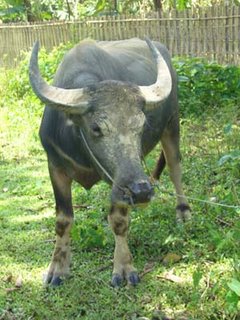
School was over near Srigobindopur:

This father and son pair were working in the tea field:
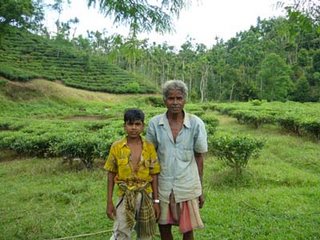
In the garden, women waited to weigh the tea they had collected. Life must be hard when so much of it depends on weight - be it tea-leaves, rubber-latex, fruits, firewood or fish.
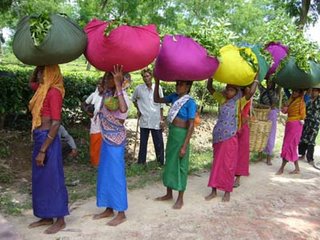
Other workers got a lunch break...

...While a boy offered guavas for sale near a labor village.

On a mandap at the foot of a large tree were remains of a prayer offering:

A drying sari lit up the landscape...

... as did this group who had just finished their weighing:
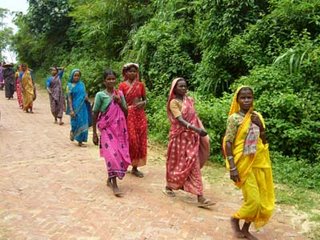
Meanwhile, it was time for the Friday shave for one of the men -
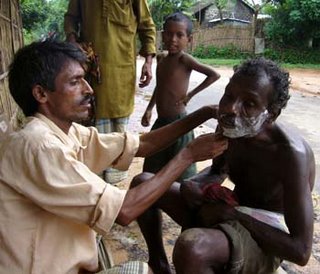
...but - as usual - the children had a better idea!

Postscript: Several years ago, I photographed the tea workers extensively. You can see some of them in my photo exhibit at the Fixing Shadows online Gallery, for example, this girl
The starting point for this loop was the HEED bungalow in Kamalganj. From there we followed the main road towards Shamshernagar until reaching a large intersection, where we turned right. Then we pretty much followed this road all the way, looping through various gardens and emerging on the main road again near Srimongol.
The road varied from paved to brick to sand. We did not encounter significant mud despite the rainy season.
It was a daytrip from Dhaka. Left Dhaka by car: 6:30am; arrived at Kamalganj: 9:30am; done biking: 3:30pm; left for Dhaka by car: 4pm; arrived home: 8:30pm.
It was beautiful in a serene, peaceful kind of way. Here are some pictures. Many thanks to Stefan for taking the initiative for the trip and navigating.
We ran into some spectacular landscapes. In the distance it was raining, but we luckily managed to stay dry:

The path was pretty though the brick portions of it jarred every bone in my body!

Many people used biycles in the villages. The boy in the foreground is too small to sit on the saddle but can ride by threading his leg through the frame's triangle. Later we met two boys who had bicycled from Shamshernagar to Srimongol (19km) for fun.

Once we lost our way and ran into these kids in a village...

... and then this Mohish (water buffalo) with whom I was very careful not to get into an argument!

School was over near Srigobindopur:

This father and son pair were working in the tea field:

In the garden, women waited to weigh the tea they had collected. Life must be hard when so much of it depends on weight - be it tea-leaves, rubber-latex, fruits, firewood or fish.

Other workers got a lunch break...

...While a boy offered guavas for sale near a labor village.

On a mandap at the foot of a large tree were remains of a prayer offering:

A drying sari lit up the landscape...

... as did this group who had just finished their weighing:

Meanwhile, it was time for the Friday shave for one of the men -

...but - as usual - the children had a better idea!

Postscript: Several years ago, I photographed the tea workers extensively. You can see some of them in my photo exhibit at the Fixing Shadows online Gallery, for example, this girl
Monday, July 03, 2006
Anwar Choudhury on Mirror Talk Show Tomorrow
Just a quick note, my better half Sonia will interview the British High Commissioner Anwar Choudhury on the Mirror Talk Show on Bangladeshi TV Channel I. At 6:20pm BDT, 1:20PM UK, and 5:20 am California.
Sunday, May 28, 2006
Bangladeshis in London
I lived in London from 1975 to 1977. Those were dark days for Bangladeshis (indeed, all immigrants) in London. Racism was rampant and economically the Bangladeshis inhabited the bottom of the food chain.
Two weeks ago I visited London as part of a business delegation. I had some meetings in Brick Lane and got to re-visit some of the "slums" I remembered from earlier days. Boy have things changed!
Bangladeshis (specially 2nd and 3rd generation) are now an upwardly-mobile group in the UK. Brick Lane thrives with rushing young people running their own businesses.
Not only do Bangladeshis own over 20000 restaurants in the UK, they sometimes co-opt other cuisine and give it a Bangladeshi taste. Eg, "Perfect Fried Chicken", a Bangladeshi-owned chain, takes the traditional Doner Kabab (Gyros) and fries it with chilis and Bengali spices to turn out a Bangladeshi Doner Kabab. I thought a good Doner Kabab could not be improved but these guys proved me wrong.
Bangladeshis hold many high-profile positions in the UK. For example, Irene Khan, the chief of Amnesty International, is from Bangladesh. So is the new mayor of Tower Hamlet Borough. The Qureshi family is probably a record-breaker in having three elected officials, called "Councillors", in London. And of course, Anwar Choudhury, the British High Commissioner in Dhaka.
In the (rather fat) book "Probashir Katha", Nurul Islam chronicles how the Bangladeshis - most of them from Sylhet - arrived in the UK. For example, Bangladeshi sailors fought alongside the British in the First world war and are mentioned in War Memorials in London. During the 1970s, several Bangladeshis were killed in racist violence.
But the persistence of this community - particularly in educating their younger generations - has paid off. I congratulate them on their success.
A signpost on Tower Bridge pointing to Banglatown:

A park in memory of Altab Ali, killed by racists in 1978:

Two weeks ago I visited London as part of a business delegation. I had some meetings in Brick Lane and got to re-visit some of the "slums" I remembered from earlier days. Boy have things changed!
Bangladeshis (specially 2nd and 3rd generation) are now an upwardly-mobile group in the UK. Brick Lane thrives with rushing young people running their own businesses.
Not only do Bangladeshis own over 20000 restaurants in the UK, they sometimes co-opt other cuisine and give it a Bangladeshi taste. Eg, "Perfect Fried Chicken", a Bangladeshi-owned chain, takes the traditional Doner Kabab (Gyros) and fries it with chilis and Bengali spices to turn out a Bangladeshi Doner Kabab. I thought a good Doner Kabab could not be improved but these guys proved me wrong.
Bangladeshis hold many high-profile positions in the UK. For example, Irene Khan, the chief of Amnesty International, is from Bangladesh. So is the new mayor of Tower Hamlet Borough. The Qureshi family is probably a record-breaker in having three elected officials, called "Councillors", in London. And of course, Anwar Choudhury, the British High Commissioner in Dhaka.
In the (rather fat) book "Probashir Katha", Nurul Islam chronicles how the Bangladeshis - most of them from Sylhet - arrived in the UK. For example, Bangladeshi sailors fought alongside the British in the First world war and are mentioned in War Memorials in London. During the 1970s, several Bangladeshis were killed in racist violence.
But the persistence of this community - particularly in educating their younger generations - has paid off. I congratulate them on their success.
A signpost on Tower Bridge pointing to Banglatown:

A park in memory of Altab Ali, killed by racists in 1978:

Friday, April 28, 2006
Things to do in Sylhet
Sylhet is my hometown, although I left at 9 and am a little estranged.
Here are some nice places that I discovered (or rediscovered):
a) Area around parjatan motel - nice spot, lots of nice views from a hill top on Airport road
b) Shahjalal University - pretty campus about 10 km N of town
c) Zakaria Resort - near Khadimnagar, a hilltop resort with 360 views and entertainment park including ferris wheel and toy train
d) Hazrat Shahjalal's tomb - he was an amazing holy man, worth a visit if you are religious
e) MC College (aka Sylhet Govt College) another nice campus
f) Forest Dept Land - some nice forests on north-east side of town, near Baluchar. There was a picnic spot but it may have shut down.
g) Tea gardens - Lakkatura and Malnichhara are very close to town. Bicycling possible on the trails (though I have not tried it.)
If you like shopping, Manipuri patterned saris etc in Police Line.
In summary, places just a little on the outskirts are nice. Avoid the center, specially Zindabazar and Bandar, unless you like crowds and traffic jams.
One view from top of Zakaria Resort:

View to the East from Zakaria:

Stadium under construction near Lakkatura:

Storm Lilly:
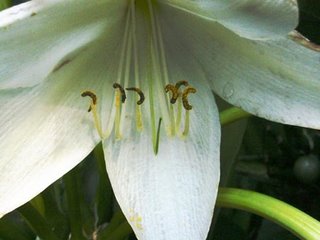
What tractors were really made for:

Another type of Lilly:

Here are some nice places that I discovered (or rediscovered):
a) Area around parjatan motel - nice spot, lots of nice views from a hill top on Airport road
b) Shahjalal University - pretty campus about 10 km N of town
c) Zakaria Resort - near Khadimnagar, a hilltop resort with 360 views and entertainment park including ferris wheel and toy train
d) Hazrat Shahjalal's tomb - he was an amazing holy man, worth a visit if you are religious
e) MC College (aka Sylhet Govt College) another nice campus
f) Forest Dept Land - some nice forests on north-east side of town, near Baluchar. There was a picnic spot but it may have shut down.
g) Tea gardens - Lakkatura and Malnichhara are very close to town. Bicycling possible on the trails (though I have not tried it.)
If you like shopping, Manipuri patterned saris etc in Police Line.
In summary, places just a little on the outskirts are nice. Avoid the center, specially Zindabazar and Bandar, unless you like crowds and traffic jams.
One view from top of Zakaria Resort:

View to the East from Zakaria:

Stadium under construction near Lakkatura:

Storm Lilly:

What tractors were really made for:

Another type of Lilly:

A Bus Trip
In recent years, bus service in Bangladesh has improved. Recently I travelled Dhaka-Sylhet-Dhaka by private bus. I was amazed at the high quality.
Planning the trip, I called various bus companies and Shohag appeared the most courteous and professional. Yes, they had many busses from Dhaka to Sylhet, what time would I like to leave, etc. Then the surprising question, "Would you like to travel by Business Class or Economy Class sir?" The prices were Tk 600 ($9) and 400 ($6) respectively so I said why not, this is the time to splurge.
When I got to the "terminal" at my "reporting time" and on to my assigned seat A1, a comfortably wide seat in front of the bus with at least 3 feet of legroom, I found a small pillow that appeared stuck on the seatback, uncomfortably behind by top vertebrum. I could not dislodge it and so asked for help. No problem: an ingenious sliding mechanism, using sewn-in ribbons, allowed the pillow to be slid up to behind the seatback.
In addition to the reclining seatback I also had a foot rest that popped out, an airline-like swivelling LCD TV (Business class exclusive), a massage system (which I could not get to work) and headphone audio system (which was also dicey.) Like planes, there was a mesh pocket attached to the back of the seat in front (in my case, on a panel in the front.) There were reading lights and individually controllable AC vents.
A "flight attendant" accompanied us and made several excruciatingly polite announcements in Bangla. My favorite one was when we arrived at our only break and pit-stop when he said "I hope my dear passengers will be able to satisfy all their needs at this stop." As in go to the bathroom.
Oh yeah, the bus had no bathroom. That was the only drawback. But that one stop it made halfway into the 5-hour trip was enough. Of course if you have diarrhoea you are dead.
Shortly after starting the attendant stuffed bottled water, a Cola can, a packet of crackers and two AlpenLiebe candies (Indian version of Werther's) into the mesh pocket.
The attendant also sprayed air-freshener a few times up and down the bus, near the floor. So, no odor problems.
There was a 15"(?) TV mounted on the top where they showed Bangladeshi programs. I enjoyed a program showing the "best of" Close-Up talent contest (though the headset jacks needed to be prodded often.) They also showed Mr. Bean episodes plus some dramas. But no Hindi stuff. However, the LCD monitor in Business Class had a second channel where they showed Bollywood.
All the Shohag employees were smartly dressed in beige shirts, ties and black pants. Most were polite but good salespeople at the same time.
The ride was ok, although the driver was quite generous with his honking (loud and shrill) and with tailgating and swerving around vehicles in front. The horn of this monster bus has a special sound that warns everyone in front to get out of the way.
The trip to Sylhet, estimated to be 4.5 hours, took five. On the way back the journey took 7.5 hours because we were stuck at Jatrabari (entrance to Dhaka) for about 3 hours. (Ugh. How I hate Jatrabari.)
Before the AC busses, passengers had suffered mightily over the years because of the difficulty in obtaining tickets for Biman or Railways (usually graft-related.) Now Biman and Rail tickets are no problem, because competition from busses have straightened them out.
Short of actually flying, these busses have emulated (with success) airline service every step of the way. In addition to the cabin service, they issue airline-like tickets and a check-in service with luggage tags for checking in larger bags into the bus belly.
Years ago, when my wife and I were travelling in Mexico, we were surprised by their assigned seating busses and polite service and wondered by Bangladeshi busses could not provide better service. No more - world-class bus service has come to Bangladesh.
I congratulate those who made these high-quality busses happen. The in-depth thought to every bit of customer experience shows in the meticulous execution.
Now, please tell your drivers to drive a little more carefully on the highway, ok? Oh yeah, what's with the ugly pink color?
Here is the bus:

And here is the view from inside:
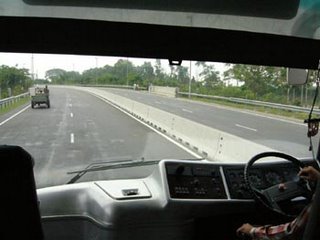
Planning the trip, I called various bus companies and Shohag appeared the most courteous and professional. Yes, they had many busses from Dhaka to Sylhet, what time would I like to leave, etc. Then the surprising question, "Would you like to travel by Business Class or Economy Class sir?" The prices were Tk 600 ($9) and 400 ($6) respectively so I said why not, this is the time to splurge.
When I got to the "terminal" at my "reporting time" and on to my assigned seat A1, a comfortably wide seat in front of the bus with at least 3 feet of legroom, I found a small pillow that appeared stuck on the seatback, uncomfortably behind by top vertebrum. I could not dislodge it and so asked for help. No problem: an ingenious sliding mechanism, using sewn-in ribbons, allowed the pillow to be slid up to behind the seatback.
In addition to the reclining seatback I also had a foot rest that popped out, an airline-like swivelling LCD TV (Business class exclusive), a massage system (which I could not get to work) and headphone audio system (which was also dicey.) Like planes, there was a mesh pocket attached to the back of the seat in front (in my case, on a panel in the front.) There were reading lights and individually controllable AC vents.
A "flight attendant" accompanied us and made several excruciatingly polite announcements in Bangla. My favorite one was when we arrived at our only break and pit-stop when he said "I hope my dear passengers will be able to satisfy all their needs at this stop." As in go to the bathroom.
Oh yeah, the bus had no bathroom. That was the only drawback. But that one stop it made halfway into the 5-hour trip was enough. Of course if you have diarrhoea you are dead.
Shortly after starting the attendant stuffed bottled water, a Cola can, a packet of crackers and two AlpenLiebe candies (Indian version of Werther's) into the mesh pocket.
The attendant also sprayed air-freshener a few times up and down the bus, near the floor. So, no odor problems.
There was a 15"(?) TV mounted on the top where they showed Bangladeshi programs. I enjoyed a program showing the "best of" Close-Up talent contest (though the headset jacks needed to be prodded often.) They also showed Mr. Bean episodes plus some dramas. But no Hindi stuff. However, the LCD monitor in Business Class had a second channel where they showed Bollywood.
All the Shohag employees were smartly dressed in beige shirts, ties and black pants. Most were polite but good salespeople at the same time.
The ride was ok, although the driver was quite generous with his honking (loud and shrill) and with tailgating and swerving around vehicles in front. The horn of this monster bus has a special sound that warns everyone in front to get out of the way.
The trip to Sylhet, estimated to be 4.5 hours, took five. On the way back the journey took 7.5 hours because we were stuck at Jatrabari (entrance to Dhaka) for about 3 hours. (Ugh. How I hate Jatrabari.)
Before the AC busses, passengers had suffered mightily over the years because of the difficulty in obtaining tickets for Biman or Railways (usually graft-related.) Now Biman and Rail tickets are no problem, because competition from busses have straightened them out.
Short of actually flying, these busses have emulated (with success) airline service every step of the way. In addition to the cabin service, they issue airline-like tickets and a check-in service with luggage tags for checking in larger bags into the bus belly.
Years ago, when my wife and I were travelling in Mexico, we were surprised by their assigned seating busses and polite service and wondered by Bangladeshi busses could not provide better service. No more - world-class bus service has come to Bangladesh.
I congratulate those who made these high-quality busses happen. The in-depth thought to every bit of customer experience shows in the meticulous execution.
Now, please tell your drivers to drive a little more carefully on the highway, ok? Oh yeah, what's with the ugly pink color?
Here is the bus:

And here is the view from inside:

Subscribe to:
Posts (Atom)